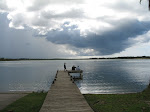Yesterday was April 26th. It was sunny and about 85 degrees outside in New York City. Although we all enjoyed the early summer day it was worrisome. Today was the warmest day on record. Watching a science briefing on the results of the recent arctic studies cemented the concerns.
The sea ice in the arctic is melting faster than the scientific models have predicted. There is new evidence that we could see a complete melting of sea ice in the summer months only about five years from now. The melting of the sea ice would cause the earth's Arctic Ocean to heat up faster, as ice reflects the sun's rays back into space like a mirror whereas the oceans absorb heat. That would warm the arctic region releasing vast amounts of methane trapped in the currently frozen permafrost. Methane is a greenhouse gas with a much greater capacity for heat retention than carbon dioxide. This could heat up our planet to uninhabitable levels in some areas.
The Greenland ice sheet is the largest fresh water reserve in the world, next to Antarctica. It is currently melting faster than scientific models have predicted as well. The melting of this glacial area could cause a substantial rise in the water level of the earths oceans leaving coastal areas permanently under water. The estimated rise in the water table of earth's oceans has been estimated to be as much as twenty feet.
Additionally, adding that much fresh water could cause a dilution in the salinity of the seas, slowing or stopping the North Atlantic Current. This current is responsible for bringing warm sea water from the southern Atlantic Ocean up through Nova Scotia and across to Europe where it ultimately cools and returns to the southern seas. Without this pattern, the southern seas would become warmer and warmer. This current is responsible for the moderate temperatures that North America and Europe currently enjoy. Without those moderating currents, the Northern hemisphere would be substantially colder than it is now.
The increase in the temperature of the southern seas, due to the cessation of the North Atlantic Current, would spawn more super storms all over the world (eg: hurricanes Katrina, Rita and Ike). We could have arid areas experiencing extreme water shortages as well as other areas that suffer massive flooding. Permanently flooded coastal areas could resettle large populations inland causing additional drains on already scarce resources.
There are viable solutions to address the increased carbon dioxide dilemma. We have the technology to produce enough power from renewable energy sources right now. We need funding from government and private industry to create a cleaner future. It is time for corporate greed to be replace by the vision of a habitable planet for our children and grandchildren. We must act within the very near future to save humanity from the devastation that may follow further increases in greenhouse gas levels. It will not matter to our children that they have a balanced budget if they don't have a planet upon which they can live. We must invest in clean energy and solve this crisis before it is too late.
Monday, April 27, 2009
Is It Already Too Late to Save Ourselves?
Subscribe to:
Post Comments (Atom)





















No comments:
Post a Comment